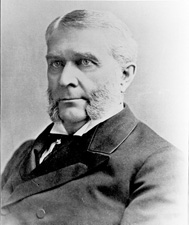William D. Washburn
William Drew Washburn (born January 14, 1831 in Livermore , Androscoggin County , Maine , † July 29, 1912 in Minneapolis , Minnesota ) was an American politician ( Republican Party ) who represented the state of Minnesota in both chambers of Congress .
William Washburn came from a family that produced numerous politicians. Three of his seven brothers also embarked on a political career and sat like him in the House of Representatives of the United States - but each for a different state: Israel (1813–1883) for Maine, Elihu (1816–1887) for Illinois and Cadwallader (1818–1883) 1882) for Wisconsin . Israel and Cadwallader Washburn were also governors of their respective states, Elihu Washburne - who added an "e" to his last name - also served for a few days as United States Secretary of State under President Ulysses S. Grant .
After graduating from Bowdoin College William Washburn studied at Bangor under John A. Peters , a later congressman from Maine, the law before he moved to Minneapolis in 1857. There he practiced as a lawyer and worked for the Minneapolis Milling Company founded by his brother Cadwallader . He also began to work as a businessman and became one of the wealthiest men in Minnesota through success in the timber and flour trade. From 1883 to 1889 he served as the first president of the Minneapolis Railroad Company , Sault Ste. Marie and Atlantic Railroad or its successor company Minneapolis, St. Paul and Sault Ste. Marie Railway (Soo Line). He also founded the Pillsbury-Washburn Milling Company , which then became the Pillsbury Company ; this in turn went into General Mills , the successor company of the Milling Company run by his brother .
In his first public office as chief surveyor ( Surveyor General ) of Minnesota, based in Saint Paul , Washburn was appointed by President Abraham Lincoln in 1861 ; he held it until 1865. In 1864 he first ran for a seat in the US House of Representatives, but lost the election. After serving in the House of Representatives from Minnesota for several session periods, he succeeded in the election of 1878 in the Congress, where he represented the interests of Minnesota from March 4, 1879 to March 3, 1885. He then resigned from parliament, but then ran for election to the US Senate in 1888 , which he won. After six years in office from March 4, 1889 to March 3, 1895, Washburn missed re-election.
After his departure from politics, Washburn went back to his business activities. He spent the last years of his life on his property "Fair Oaks", the surroundings of which had been artistically designed by landscape architect Frederick Law Olmsted . The house was demolished in 1924 to make way for a park; today the area is part of the Washburn-Fair Oaks Mansion District , which was added to the National Register of Historic Places in 1977.
Web links
- William D. Washburn in the Biographical Directory of the United States Congress (English)
- William D. Washburn in the database of Find a Grave (English)
| personal data | |
|---|---|
| SURNAME | Washburn, William D. |
| ALTERNATIVE NAMES | Washburn, William Drew (full name) |
| BRIEF DESCRIPTION | American politician |
| DATE OF BIRTH | January 14, 1831 |
| PLACE OF BIRTH | Livermore , Androscoggin County , Maine |
| DATE OF DEATH | July 29, 1912 |
| Place of death | Minneapolis , Minnesota |


